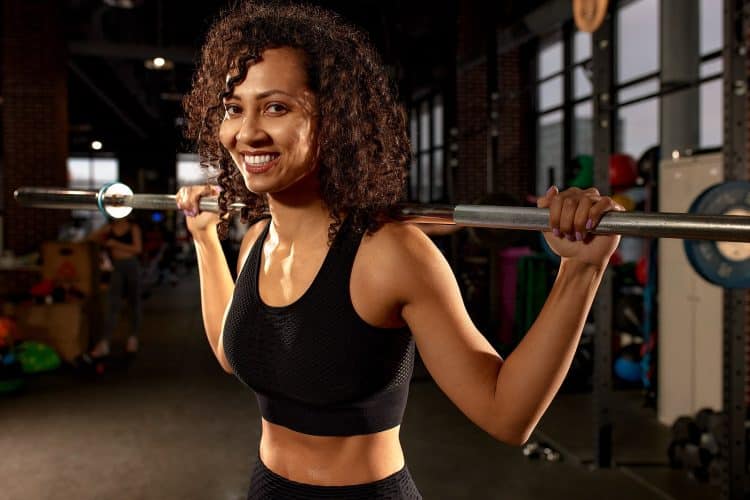
Many women choose cardio over weight and strength training for reasons like feeling intimidated by the gym, fear of bulking up, not having enough time, or others, but there are several benefits that come from incorporating weight training into your regular routine. And, it doesn’t have to be difficult or intimidating – two to three weight or strength-based workouts each week can result in significant health benefits.
Read on to learn more about the benefits of weightlifting for women, as well as 10 weight training tips to help you with your routine.
Benefits of Strength Training for Women
We all know exercise is important for our physical and mental health, but weight and strength training have a number of additional benefits, especially for women, such as:
- You’ll experience increased muscle mass, stronger bones, a boosted metabolism, better posture and balance, and increased joint flexibility.
- It burns body fat.
- You’ll be (and feel) stronger.
- You’ll be at less risk for injury doing other things you love, and it can also help reduce pain.
- It can combat age-related muscle and bone loss, helping to prevent chronic conditions such as osteoporosis.
- It improves overall body composition.
- It can help ward off chronic diseases and illness, such as cardiovascular disease, diabetes, obesity, stroke, and others.
- You’ll feel improved mood and mental health.
Top 10 Weight Training Tips
1. Never skip the warm-up.
Lifting with cold muscles can quickly lead to injury. It’s important to increase blood flow and heart rate to improve your muscles’ ability to respond to resistance. Warming up properly can also increase circulation and improve range of motion, bettering the impact of your workout.
Try a dynamic warm up, such as squats, pushups, lunges, and jumping jacks.
2. Know proper form and technique.
Sloppy or incorrect form is a sure way to injury, but in the heat of exercising, it isn’t given a lot of thought. And, because women have naturally wider hips than men, they are more at risk for form-related injuries so it’s especially important for women who weight train.
Before you begin any exercise, make sure your head is over your shoulders, shoulders over hips, and hips over feet. Keep your eyes straight ahead, abs tight, and knees over your second toe. If you don’t know how to do an exercise correctly, ask a fitness professional.
Proper form will allow you to get best results and stay injury-free.
3. Stick to the basics.
Especially if you’re just getting into strength training, it’s better to stick with a few exercises for the first few weeks (or even months) instead of jumping into heavy weights or complex moves. Your body will remember and memorize a few movements and forms more quickly, so mastering the technique and improving strength on basic exercises can help you build the foundation you need for more advanced lifting.
Some of the best weightlifting moves to begin with include:
- Weighted squats
- Deadlifts
- Reverse lunge (with light weight)
- Glute bridge
- Inverted row
- Overhead press
4. Don’t be afraid of alternatives.
Many women think that by doing a modified or alternative move, it means they are “weak” or “giving up.” However, in some cases, you may have to use appropriate substitutions, especially if you have mobility issues that don’t allow you to perform exercise safely and properly.
Pushing yourself too hard or too fast will likely lead to injury, so take time to master the basics, add weight slowly over time, and if you need to modify until you’re stronger or more comfortable, do so.
5. Don’t neglect the upper body.
We often hear women say they shy away from working the upper body for fear of “bulking up,” but there are many upper body exercises that are extremely beneficial to improving posture and preventing injury. Weight bearing exercises and resistance training have also been proven to prevent osteoporosis.
Proper weight training the upper body, including biceps, triceps, chest, back, and abs, should not be ignored. Plus, it’s very unlikely that doing so will cause “bulking up” based on female body and muscle composition.
6. Work opposing muscle groups.
Oftentimes, women find they have strength imbalances, which can make them more prone to injury. This is typically a result of lifestyle (such as sitting at a desk for work) or by not working all sides of the body equally.
For every exercise that works the front of the body, try to also do something that targets the back. Mixing up upper and lower body lifts, as well as alternating moves throughout each day and week, can help you avoid muscle fatigue or muscle memory while balancing your strength.
However, note you don’t always have to work every muscle individually with isolation exercises. Compound exercises (especially with weight machines or dumbbells) help you master your form and get stronger all around.
7. Focus on getting stronger.
You may have a variety of goals and reasons for starting weightlifting, and one of them should be to get stronger. This is especially important for beginners because they need to develop a base level of strength before lifting more or heavier.
Focusing on building strength is the best way to get results and is a motivating way to keep going and not dread your workouts. Beginners make fast initial strength improvements, and getting stronger week over week allows you to experience positive progress over time.
Beginners also are better off keeping reps low for more effective and impactful exercise.
8. Be consistent.
The key to weight training is to not give up. You won’t see results right away, but many women who begin weight training do start seeing results within the first few weeks. Try to remember the importance of building a healthy lifetime habit, and that lifting for one or two months and then stopping won’t give you the strength or results you want.
Work your way up to training 3-4 days a week but remember you don’t have to be working out for hours each day. Repetition is key, as is consistency.
9. Listen to your body.
Doing too much too soon (such as more reps, more sets, more weight, or too much out of the gate) can actually hurt your body, often leading to torn ligaments, tendinitis, and muscle strains and tears. Start by learning a move using only your body weight, then slowly add light weights for a few days or weeks (or until you feel comfortable). Then, add another set or more weight, and work your way up over time.
Also note the difference between muscle fatigue from a good workout and actual pain. You should feel some muscle fatigue in the muscles you’re targeting, but:
- Feeling nothing at all likely indicates you’re taking it too easy.
- Feeling pain, especially in an area other than the muscles you’re working, could mean you’re using incorrect form or you’re near injury.
Also, if your body needs a day to rest and recover, that’s ok. Overworking muscles and furthering injury can hurt you must more in the long run than taking an additional recovery day.
10. Work with a qualified, educated fitness professional.
A fitness professional can help you understand the proper form and technique of each exercise. They can also work with you to design a personalized health and wellness program to help you reach your goals and avoid injury, including offering tips for modifying your current lifestyle. They are also here to motivate and educate you, build your confidence, and help you get the results you’re looking for while building lifelong healthy habits.
Start Today
Consider hiring a fitness professional who has received their Personal Training Diploma from NPTI Florida (Orlando/Tampa). With hundreds of hours of live college curriculum and 218-hours of hands-on training experience in a fitness center, these professionals are well equipped to help you reach your goals safely and effectively. Additionally, all NPTI Florida fitness professionals have liability insurance.
Or, if you’re interested in becoming fitness professional, contact us today to learn more about our Accredited Personal Training Diploma programs.
Tags: Weight Training
